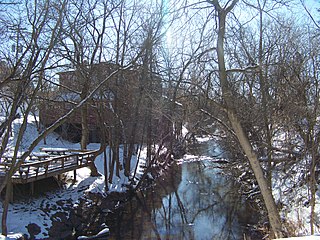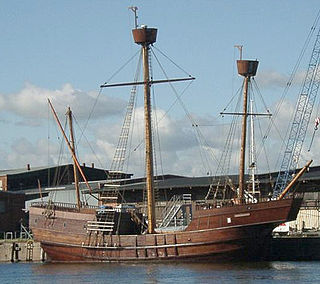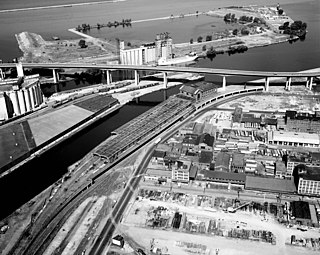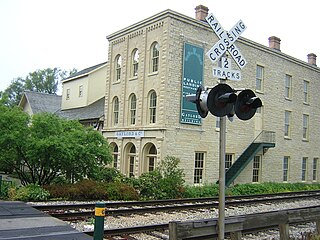Related Research Articles
The Erie Canal in New York is part of the east–west, cross-state route of the New York State Canal System. It originally ran 363 miles (584 km) from the Hudson River in Albany to Lake Erie in Buffalo. It was built to create a navigable water route from New York City and the Atlantic Ocean to the Great Lakes. It was completed in 1825 and was the second longest canal in the world, and it greatly enhanced the development and economy of the cities of New York, including Albany, Syracuse, Rochester, Buffalo, and New York City, as well as the United States. This was in part due to the new ease of transport of salt and other goods, and industries that developed around those.

Lockport is a city and the county seat of Niagara County, New York, surrounded by the town of Lockport. The population was 21,165 at the 2010 census, with an estimated population of 20,305 as of 2019. It is named from a set of Erie Canal locks within the city. It is part of the Buffalo–Niagara Falls Metropolitan Statistical Area.

A maritime museum is a museum specializing in the display of objects relating to ships and travel on large bodies of water. A subcategory of maritime museums are naval museums, which focus on navies and the military use of the sea.

The Wabash and Erie Canal was a shipping canal that linked the Great Lakes to the Ohio River via an artificial waterway. The canal provided traders with access from the Great Lakes all the way to the Gulf of Mexico. Over 460 miles long, it was the longest canal ever built in North America.

The Chenango Canal was a towpath canal built and operated in the mid-19th century in central New York in the United States. It was 97 miles long and for much of its course followed the Chenango River, along Rt. 12 N-S from Binghamton on the south end to Utica on the north end. It operated from 1834 to 1878 and provided a significant link in the water transportation system of the northeastern U.S., connecting the Susquehanna River to the Erie Canal.

USS Niagara, commonly called the US Brig Niagara or the Flagship Niagara, is a wooden-hulled snow-brig that served as the relief flagship for Oliver Hazard Perry in the Battle of Lake Erie during the War of 1812. As the ship is certified for sail training by the United States Coast Guard, she is also designated SSV Niagara. Niagara is usually docked behind the Erie Maritime Museum in downtown Erie in the U.S. state of Pennsylvania as an outdoor exhibit for the museum. She also often travels the Great Lakes during the summer, serving as an ambassador of Pennsylvania when not docked. It was listed on the National Register of Historic Places in 1973 and was designated the official state ship of Pennsylvania by the Pennsylvania General Assembly in 1988.

The Durham boat was a large wooden, flat-bottomed, double-ended freight boat which was in use on many of the interior waterways of North America beginning in the middle of the eighteenth century. They were displaced by larger, more efficient canal boats during the canal era beginning with the opening of the Erie Canal in 1825. The Durham name became associated with this boat type due to their use by the Durham Ironworks of Durham, Pennsylvania for hauling freight on the Delaware River. They are also noted for their use in George Washington's crossing of the Delaware River during the American Revolution.

A ship replica is a reconstruction of a no longer existing ship. Replicas can range from authentically reconstructed, fully seaworthy ships, to ships of modern construction that give an impression of a historic vessel. Some replicas may not even be seaworthy, but built for other educational or entertainment purposes.

The Vermilion Lighthouse is a lighthouse on the shores of Lake Erie in Vermilion, Ohio, USA. It is situated on the grounds of the Inland Seas Maritime Museum near the mouth of the Vermilion River. Erected on 23 October 1991 and dedicated on 6 June 1992, the lighthouse is illuminated by a 200 watt incandescent light bulb with a 5th order Fresnel lens. The lighthouse's United States Coast Guard-mandated light color is steady red.

The Buffalo and Erie County Naval & Military Park, formerly known as The Buffalo Naval and Servicemen's Park, is a museum on the shore of Lake Erie in Buffalo, New York. It is home to several decommissioned US Naval vessels, including the Cleveland-class cruiser USS Little Rock, the Fletcher-class destroyer USS The Sullivans, and the submarine USS Croaker. All three are open to the public for tours.

The Metro Rail Maintenance Yard or "South Park Terminal" houses Buffalo Metro Rail's cars in a train shed at the former Delaware, Lackawanna and Western Railroad terminal in the Cobblestone District of Buffalo, New York. The property is located at the southernmost fringe of the Central Business District. The station was built in 1917, and was designed to handle both steam trains and steamships. The storage and maintenance facility was converted to its present condition in 1982, following the demolition of the former main terminal concourse building "headhouse" of the DL&W Terminal in 1979.

The Gaylord Building, constructed in 1838 in the downtown historic district of Lockport, Illinois, and on the canalside there, played a pivotal role in the construction of the Illinois and Michigan Canal. It is on the United States National Register of Historic Places, and is one of 29 Historic Sites of the National Trust for Historic Preservation. It is constructed of yellow limestone, a common construction material in north central Illinois. It has an Italianate three story addition added in 1859. After falling into disrepair, it was the focus of a concerted restoration and preservation effort that began in 1983, which was later noted as setting a model for such efforts.

The Erie Canal Museum is a historical museum about the Erie Canal located in Syracuse, New York. The museum was founded in 1962 and is a private, non-profit corporation. It is housed in the Syracuse Weighlock Building dating from 1850. The Syracuse Weighlock Building was in operation as a weighlock from 1850 to 1883. In 1883 the canal decided to stop charging tolls. The weighlock building was essentially used as a big, elaborate scale to weigh the boats traveling on the Erie Canal and determine how much each boat would pay for a toll. Today the museum includes not only artifacts from the Erie Canal, but also a gallery of present canal life. It is the mission of the museum to help people to learn the rich history of the Erie Canal and that it is not just a thing of the past, but still very much exists today in different forms.
With facilities open to the public May through mid-October, the Lake Champlain Maritime Museum (LCMM) is non-profit museum located in Vergennes, Vermont, USA. Its mission is to preserve and share the history and archaeology of Lake Champlain. As a maritime museum specializing in archaeology, LCMM studies the hundreds of shipwrecks discovered in Lake Champlain and plays a major role in the management of those cultural resources. Through the preservation and interpretation of those and other artifacts, the museum tells the story of the people and culture of the Lake Champlain region.

The Buffalo History Museum is located at 1 Museum Court in Buffalo, New York, just east of Elmwood Avenue and off of Nottingham Terrace, north of the Scajaquada Expressway, in the northwest corner of Delaware Park.

Canalside, formerly known as Canal Side and Erie Canal Harbor, is a master-planned neighborhood and festival marketplace within the inner harbor of Buffalo, New York. Envisioned as a recreation of the western terminus of the Erie Canal, Canalside is situated on the Buffalo River, where the area was historically home to the Seneca people.

Day Peckinpaugh is a historic canal motorship berthed at the Matton Shipyard on Peebles Island, Cohoes in Albany County, New York, United States.

Unity Island is an approximately 160-acre (0.65 km2) island separating the Niagara River and the Black Rock Canal, located within the city limits of Buffalo, New York. The historic island is home to two public parks and a water treatment facility. It is connected to the mainland by a steel deck Rolling bascule bridge.

The National Museum of the Great Lakes is a museum in the Toledo Maritime Center, a heritage location on the banks of the Maumee River on the east side of Toledo, Ohio. Operated by the Great Lakes Historical Society, it celebrates the natural and built heritage of the North American Great Lakes from a U.S. perspective. The museum is most noted as the docking location of a museum Lake freighter, the SS Col. James M. Schoonmaker.

Buffalo Harbor State Park is a 190-acre (0.77 km2) state park and marina on the shore of Lake Erie in the city of Buffalo in Erie County, New York. The park encompasses Gallagher Beach, the former NFTA Small Boat Harbor, and the waterfront land in between.
References
- ↑ "Buffalo Maritime Center". buffaloah.com.
- 1 2 3 Norton, Schyler (7 February 2017). "Making Waves: The Buffalo Maritime Center". Buffalo Rising . Retrieved 1 August 2019.
- ↑ "New York Maritime Museums". www.maritimemuseums.net.
- ↑ "HHL Architecture". www.hhlarchitects.com.
- ↑ "High Schoolers Applying STEM Skills to Boat Building". spectrumlocalnews.com. 2019-05-22.
- ↑ Cason, Rikki. "Building history: 'Durham' boat construction for Flight of Five demo'ing is well underway". Lockport Union-Sun & Journal.
- ↑ Sommer, Mark (15 March 2019). "Canalside packet boat construction takes step forward". Buffalo News. Retrieved 1 August 2019.
- ↑ "Canal Corp., Buffalo Maritime Center unveil new phase in building of replica of historic Erie Canal boat". Spectrum News Buffalo. 14 March 2019. Retrieved 2 August 2019.
- ↑ Epstein, Jonathan D. (January 28, 2019). "'You're looking at Canalside 2.0': Longshed building wins city approval". Buffalo News.
- ↑ Desmond, Mark (17 January 2019). "New Longshed for Canalside's Commercial Slip sails ahead". WBFO.
- ↑ Desmond, Mike (19 December 2018). "Replica packet boat will cruise Buffalo's Erie Canal history". WBFO. Retrieved 2 August 2019.
- ↑ Popiolkowski, Joseph (9 January 2010). "Crew constructs mold for traditional canoes". Buffalo News.